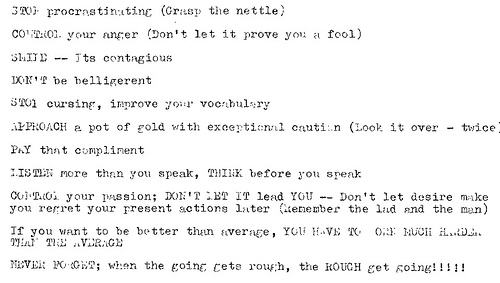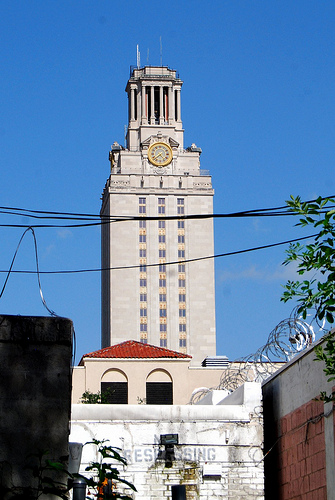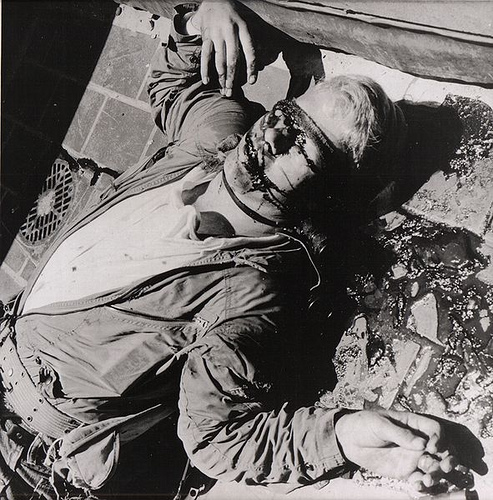44 Years after the UT Tower Massacre, is Charles Whitman still a bad guy? [GRAPHIC PICS]
Editor’s note: Please welcome Matthew, the newest blogger at RoA. He’s a super huge history buff, and will be looking at snippets from Austin’s past to help us understand the present. He and his girlfriend recently moved to Austin. You can read about their adventures over at his other blog, Lonestarters.
Here are some great tips from a mass-murderer on how to start out your day:
It was 44 years ago this past Sunday (August 1st, kids) that a perhaps delusional and certainly insane former marine killed his immediate family, conned his way to the top of the University of Texas clock tower and shot indiscriminately at civilians for the next 90 minutes. When I was like 10 years old, I saw one of those docu-dramas on TV about the UT massacre. I had a map of the US states on my bedroom wall, and after watching it, I looked to find Austin.
“Boy,” 11 year old me thought to myself “Who’d ever want to live all the way down there?”
Haha, you know.
[Oh by the way, what a great introductory post, don't you think? Hi, I'm the new guy -- here's some pictures and information about a crazy person who once-upon-a-time tried to kill you. Aww, shooty Texans, always shooting at things.]
Meet Charles Whitman. For the next five minutes or so you’ll get to know him and probably dislike him. Just a bad dude, folks.
But was he really that bad of a dude before that day, or was it all just a result of the failures of the system and familial abuse? After all, when a dog that’s been abused bites an innocent bystander, do we blame the dog? Absolutely — we generally euthanize the dog and turn its remains into plant fertilizer. But that doesn’t mean we *should.*
In the summer of 1966, Whitman, an honorably discharged marine and UT student helped his mother move to Austin to escape his abusive father. This upsetting of the apple cart strained his already fragile family situation, and by the end of July things began to quickly unravel. Whitman’s daily journal details his steady decline into madness — a madness of which he, himself was very much aware. Finally, sometime on July 31st, 1966, Whitman snapped:
[Click to enlarge]

(The beginning of Whitman's "suicide" note details his own bewilderment with his decline into madness)
Click here for timeline, archival video, plus graphic photo of Whitman after he was shot—>
The UT Tower Massacre: A Timeline
August 1st, 1966
12 AM: Sometime around midnight, maybe a little before, Charles Whitman visited his mother’s apartment and killed her by stabbing her multiple times in the heart. After the killing, he left a note by her body, stating that he believed she would now be in heaven, if such a place existed.
3 AM: A few hours later, Whitman returned home and stabbed his sleeping wife several times in the heart. He then finished a suicide note he had started hours earlier, claiming that while it appeared that he had brutally killed his family, he had only done so to protect them from the suffering of this world. Though one must wonder if this was the case, why he chose stabbing, a particularly painful and violent form of murder, to carry out the killings. Whitman then requested an autopsy after his death to see if something was wrong that would inspire him to do this, and asked that the money from his life insurance policy be donated to research on mental health.
11 AM: By 11:30 AM, Whitman had bluffed his way past several layers of campus security, clubbed the top floor receptionist in the head with a rifle butt and headed out onto the observation deck where he began shooting.
A majority of the initial shootings occurred on Guadalupe Street, where Whitman had an unabated view from his perch. After his initial blitz of shots, armed citizens began assisting the Austin police in their answering fire. This returning volley of bullets limited Whitman to shooting through the deck’s water spout holes, which greatly limited his effective range but also mostly protected him from being hit from below.
In this chilling news footage, you can see Whitman’s figure occasionally crouching past the water spout holes, and in the second video, an exchange of gunshots:
From these news reports you’ll note two things: First, on that evening’s news, KTBC inaccurately reported the casualty count as 16 dead and 33 wounded (the final death count varies depending on a few factors, but is roughly 14 dead, 31 wounded). Secondly, the official police statement at the end of the second video claims that officer Ramiro Martinez fired the fatal shot. For some decades after the shooting, Martinez never disputed this claim, and indeed took credit for firing the shot on the day of the massacre. But it was, in actuality, fellow officer Houston McCoy who had ultimately killed Whitman that day.
The shooting had started at just before noon and ended at just before 1:30 PM, a period of roughly 90 minutes. In the course of that 90 minutes, many of Austin’s citizens, including many Vietnam veterans, risked their lives in returning fire against Whitman or rushing onto campus to pull out victims. Many years now, on the anniversary of the massacre, the UT community pays homage to the heroes of that day.
The autopsy of Whitman after his death revealed that he had had a brain tumor that may very well have been the cause of his sudden decline, as well as the cause of headaches he frequently reported. A retrospective of the incident in the following years showed that Whitman had sought medical and psychiatric help multiple times in the years leading up to the shooting, and at one point even told psychiatrist Dr. Maurice Heatly that he was “‘thinking about going up on the tower with a deer rifle and start shooting people.’” Whitman’s life insurance policy, for which he wished a bulk to be spent on mental health research in order to prevent similar tragedies in the future, is believed (though not known) to have mostly been used to pay off outstanding debts.
Because of his honorable service in the United States military, Charles Whitman’s casket, before being buried, was draped in an American flag.
—
Is Charles Whitman still a bad guy?
Do the mentally ill deserve any sort of special appeal when looking back on atrocities?
44 years later, how do you think a tragedy like this would play out on the UT Campus today?
-
(1) - Photo used under Creative Commons License. Whitmandeck, Austin: Austin History Center, 1966, http://upload.wikimedia.org/wikipedia/en/thumb/2/20/Whitmandeck.jpg/591px-Whitmandeck.jpg, (1 August 2010.)
Related posts:
- Are Austin’s graphic tees going girly? Southside Sanctuary’s Kat Britt thinks so. Linsey and Chris hit up South Side Sanctuary and talk...
- Inside Look at Austin’s ArtHouse renovation reveals 150 years of architectural history. [PICTURES] Chris takes a tour of the renovation of Austin's ArtHouse....
Related posts brought to you by Yet Another Related Posts Plugin.
Staff favorites
- Migliori Casino Online
- New Non Gamstop Casinos UK
- Non Gamstop Casinos
- Casino Not On Gamstop
- Casino Not On Gamstop
- Best Non Gamstop Casinos
- Best Non Gamstop Casinos
- UK Online Casinos Not On Gamstop
- Sports Betting Sites Not On Gamstop UK
- Online Casino
- オンラインカジノ
- Casino Sites Not On Gamstop
- Non Gamstop Casinos UK
- Non Gamstop Casinos
- Non Gamstop Casinos UK
- Casino En Ligne
- Casino Zonder Cruks
- Casinos Not On Gamstop
- UK Casino Not On Gamstop
- Casinos Not On Gamstop
- Betting Sites
- Non Gamstop Casinos
- Casino Non Aams
- Casinos Not On Gamstop
- Non Gamstop Casinos UK








I won’t say directly whether he was a bad guy or not, though I have known many people who have dealt with situations much worse than his and gone through life without these problems and instead turned their issues into something positive.
Of course with a tumor on his brain, perhaps he did have some sort of mental condition, and I would assume you would need a bit of a mental condition to rampage off killing innocent people for no actual reason.
I can’t speak directly to the University of Texas either, but I know having spent hours upon hours on our University of North Carolina campus that this problem could easily happen time and time again. Lax security and essentially nothing to slow someone down, I thought about this all the time, essentially planning my own escape routes from classrooms, especially directly after the massacre at Virginia Tech.
Though freedom and strict security do not go hand in hand, so it is a trade-off. We simply hope and trust our fellow citizens that this will not happen. I find it interesting that armed citizens were shooting back, and can honestly say if I was at that same position with a weapon I would have shot back as well.
Hopefully something like this will not happen again. Congratulations on getting to write here Matt!
Phillip,
I agree that lots of people have it worse, and I definitely would answer “yes” to whether or not he’s a bad guy. Whitman’s father was apparently a gun fanatic and very violent, but didn’t see anything wrong with it. In other words, he thought being abusive towards his wife and children was just a part of the male-female role, sadly. I think that there are some people who are unfortunately wired differently psychologically and maybe even biologically.
Jeffrey Dahmer, the cannibal from Milwaukee, said he had an insatiable thirst to eat people. His dad said he had similar urges but repressed them. So for Whitman, his predisposition to violence may well have been genetic. Who knows, of course, that doesn’t excuse it.
As for guns… I’m not really as high on hard line gun control as most people. I don’t think concealed carry on campuses or in public places is a good idea, but I certainly agree that people should have the right to defend themselves!
I worked for a company a few years ago where I got into a conversation with one of the higher ups about the shooting. He did not go to UT, but he had a colleague in the past who did.
Apparently this guy was working on his masters thesis, and shared some office or workspace with Whitman. Whitman eventually started acting very erratic to the point that this guy was scared to go in there and work, so he quietly gathered all his materials and took them home to finish writing his thesis there. Several weeks later, Whitman went up in the tower and started shooting.
Back in those days, cops didn’t carry much else than a little puny service revolver. This being Texas and all, when the shooting started, several guys just started pulling deer rifles, etc, out of their cars and trucks and started handing them out so they could lay down some cover fire. Whitman would surely have killed many more people had he not been subject to this cover fire, as he would have been unrestricted by the rain spouts.